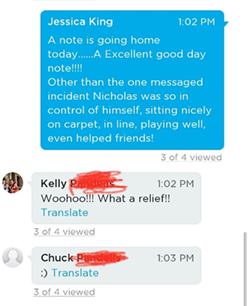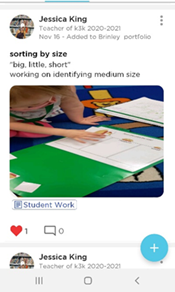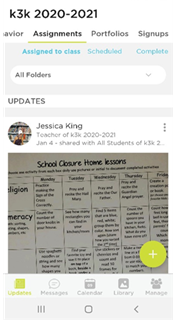Maintaining Parent-Teacher Connectedness During the Pandemic
by Jessica King, on Mar 18, 2021 12:30:00 PM
Strong parent-teacher connectedness is crucial to combating teachers and parents’ stress and anxiety during the COVID pandemic. As we know from attachment theory, parents’ own emotional states and reactions can affect a child’s temperament and emotional regulation. Similar can be true of a teacher’s emotional state reflected on his or her class. It is important to find ways to lessen the stress and anxiety levels of both parents and teachers, both for in-person and virtually teaching.
Parent-teacher connectedness helps improve children’s academic success, increase parent efficacy and most importantly REDUCE STRESS AND ANXIETY levels of teachers and parents. The COVID pandemic has altered schools’ routines and parent involvement, which is why it’s important to determine ways to build parent-teacher connectedness in an effort to lesson anxiety and stress levels for all (parents, teachers and students).
At the start of the 2020-2021 school year, across the nation teachers’ concerns and worries about health and safety entering into the school year abounded. When the pandemic first began, “how will this effect education?” was a constant thought for many I assume and what catapulted me to begin my research at the start of the pandemic. Research that I later used in my thesis. I examined the impact of parent-teacher support and communication on parent and children’s stress and anxiety levels during the pandemic’s remote learning.
Even though my data consisted of a relatively small amount of participants, it is consistent with similar studies of larger size. Results gathered at the start of the pandemic indicate the rate of stress and anxiety among both teachers and parents during the COVID school closures were high, a high level of worry or anxiety was also indicated by data through comments and ratings. Worry and stress concerning schooling and the lack thereof suggest communication that is useful, purposeful and guiding, creating a collaboration between home and family can be beneficial to the mental state of teachers and parents while also improving parents’ efficacy. A triple win-win for everyone include our students.

Fast forward to the start of the 2021 school year wherein all of these same contributing factors such as unknowns and confusing feedback again contributed to parent and teacher stress levels. I again, sent out surveys and questionnaires and began gathering data up through October 2020. Again the same factors reported contributed to stress and anxiety levels. What are these factors effecting parent and teacher anxiety? Constant change and indecisions of administrators and districts, the unknowns (managing new protocols and procedures and teaching virtually) were factors reported for directly effecting stress and anxiety levels.
While conducting research and gathering data for my thesis I discovered that there was a correlation in parents and teachers’ stress and anxiety levels with both reporting similar levels of stress and anxiety. Again, the same similar levels and factors are playing a role in parents and teachers’ current anxiety levels. Strong parent-teacher connectedness through multiple means of communication is the common denominator for low anxiety and stress levels of BOTH parents and teachers. Those who reported using multiple means of communication also reported lower stress and anxiety. This means more than just an email for communication.
42.86% Parents reported extremely worried/stressed
41.17% Teachers reported very stressed and worried
More than email and weekly or monthly newsletters - It is not the frequency of communication but the content.
Online platforms- provide opportunities for students to verbalize their learning and an added means of communication to share with parents. Students can respond and interact with each other or parents under the watchful eye of the teacher.

Messaging apps- provide immediate feedback and allow those with internet connectivity issues to gain access to videos and lessons posted on an online platform.
Emails, school websites & social media- ways in which parents can view happenings in the school, instructions that can be printed
Based on my research there are 3 ways we can all support and build parent-teacher connectedness either virtually teaching or in-person.
- Build/create trusting relationship
Must know you first before trust (Meet the Teacher handouts, expectations letters) - Provide support & guidance
Concise, brief description of classroom activities, resources, platform for sharing learning activities and process - Keep an ongoing meaningful mutual conversation
More than newsletters posted or emailed-a CONVERSATION
Opportunities for commenting and sharing feedback, open dialog (using messaging apps for immediate feedback and conversation)
So how can we support meaningful communication? Meaningful communication-communication that is useful, purposeful and guiding creates a collaboration between home and family and can be done in the following four ways:

- Share students’ learning process through pictures/videos
- Provide concise, simple explanation with pictures/videos
- Provide opportunities for students verbalize their learning and share with parents
- Provide opportunities for family involvement (learning projects, virtual family meet and greet lunches)

Even in a virtual classroom students can still collaborate and share their learning, the most important factor here is to build a strong parent-teacher connectedness using multiple means of communication. Bloomz messaging, portfolio and now the new activities option provides ways to support and build connectedness from all angles.
References:
- Bryce, Crystal I., Bradley, Robert H., Swanson, Jodi and Thompson, Marilyn S. (2018). Parents’ and teachers’ academic influences, behavioral engagement, and first and fifth-grade achievement. American Psychological Association School Psychology, 34(5), 492-502. Retrieved from http://dx.doi.org/10.1037/spq0000297
- Kuusimäki, Anne-Mari, Uusitalo-Malmivaara, Lotta and Tirri, Kirsi. (2019). The role of digital school-home communication in teacher well-being. Frontiers in Psychology, 10(Nov.), 1-8. dio:10.3389/fpsyg.2019.02257.
- Nathan, Mitchell J., and Sawyer, Keith R. (2014). Foundations of the learning sciences. In Sawyer, Keith R. (Ed.), The Cambridge Handbook of the Learning Sciences. (pp 21-43). NY: Cambridge University Press.
- REL Mid-Atlantic Educator Effectiveness Webinar Series. (2015). Engaging Families in Partnership Programs to Promote Student Success Q & A for Dr. Joyce L. Epstein. Bridge Events and Webinars Supporting Education through Research (producer). Retrieved from https://relmidatlantic.org/
- Silverman, Amy. (2020, April/May). Play, child development and relationships: a preschool teacher in China shares her virtual teaching experience. NAEYC, Teaching Young Children. Retrieved from http://www.naeyc.org
- Zhao, Yong. (2020, April 3). Beyond does it work: meaningful questions to ask about online education amid covid19 [Creative, Entrepreneurial, and Global: 21st Century Education].
- Photo by Victoria Heath on Unsplash



